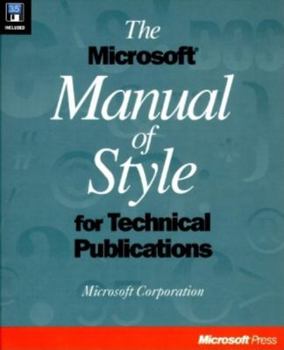The Microsoft Manual of Style for Technical Publications
Select Format
Select Condition 
Book Overview
Everyone who writes about computing needs this book, from technical writers to journalists to marketers. This authoritative reference is now fully updated and extended to cover the latest advances in... This description may be from another edition of this product.
Format:Paperback
Language:English
ISBN:1556159390
ISBN13:9781556159398
Release Date:September 1995
Publisher:Microsoft Pr
Length:292 Pages
Weight:1.40 lbs.
Dimensions:9.3" x 1.0" x 7.3"
Customer Reviews
5 ratings
Why buy it when you can download it free?
Published by Thriftbooks.com User , 22 years ago
The book is excellent! But the Microsoft press no longer prints it because it is available for download free from the Microsoft Download Center (search for the keyword "style").But it is great if you like paper copies!
Useful and Resourceful
Published by Thriftbooks.com User , 24 years ago
I am a new-comer in the area of technical documentation. I recently joined a software company as a Technical Writer and am suddenly confronted with IT terminology usage, expressions and style issues. I sought refuge in this book (a concise glossary) and in its authority. I find helpful hints in these areas. But if your issue is HOW TO do DOCUMENTATION instead of style and terminology, you should go for 'Developing Quality Technical Information : A Handbook for Writers and Editors' by Gretchen Hargis (Editor), Ann Hernandez, Polly Hughes, Jim Ramaker.
How to look real good--even if it is Microsoft
Published by Thriftbooks.com User , 26 years ago
This is an outstanding publication for anyone who uses Microsoft products, particularly Word.The genius is in its simplicity. Organized alphabetically, with tabbed pages, the index is almost unnecessary. The two Appendii, "List of Acronyms and Abbreviations" and "Special Characters" are helpful, but probably won't get much use here. A CD-ROM comes with the book, but it's faster to pick up the book and go straight to the information you need. (I love books.)The information is comprehensive, easy to find, easy to read and understand. Several screen shots "show, don't tell". Bonus: there's plenty to disagree with.Even though it is thoroughly Microsoftesque, it probably will become the standard which serious computer users rely upon. Professionals and novices can use this book on a daily basis. There's a great education in this book. I wish I had written it. It not only covers the basics (grammar, punctuation and the like), but standardizes many terms and functions relating to computers, the Web, Help systems--even ordinary documents. Macintosh computer users will find great information here, too.If you want your work to look good, this book should be on your desk.
Comprehensive, concise, and logical
Published by Thriftbooks.com User , 26 years ago
This book would be excellent to use in developing a company style guide, or it will help you out until you have time to develop a company style guide. It will also help in resolving departmental word-choice squabbles, such as whether to use "click" or "click on". And if it seems odd to tell users to "check the check box," what do you tell them?I needed this book years ago--now that I have it, I reach for it all the time. While I don't always follow its suggestions exactly, it offers me a non-trendy second opinion on technical style issues. Its straight A-Z dictionary format makes information easy to find, too.Perhaps a curious note of trivia is suitable here: the on-line help systems in many Microsoft products were not developed according to this style guide. This is unfortunate, as I find this style guide helps me write clear, approachable on-line help better than any other style guide I've seen.
Making Something Great Even Better . . .
Published by Thriftbooks.com User , 27 years ago
Already a popular tome with software documentation professionals, this new edition has much to offer both to the new reader and those who have read the previous version cover to cover.Modestly informing its readers that only 17 heavily revised or new terms have been included in this publication, the new Microsoft Manual of Style for Technical Publications has nonetheless expanded its overall topic list by a total of 144 entries. This has increased the size of the book from the previous edition by 44 pages. Many outdated and unused terms have been taken out of the manual, only to be updated to include significant changes in Internet and browser terminology and usage. From a presentation standpoint, there are minor changes to the headings and body text. Of particular note however is the new alphabetical tabbing appearing on the outer edge of the document to help locate the topics. The index is structured to contain more subentry references as well. Gone however is Appendix C, the Words with Numbers section.As with the earlier edition of the manual, this copy contains a standard Windows Help system version of the book. To demonstrate support of its new HTML-based Help standard however, Microsoft has also enclosed the same information on an HTML Help system (what it refers to in the manual as an "electronic book"). For additional incentive, there is also an HTML Help version of the third edition of the Microsoft Press Computer Dictionary - another helpful resource. Be aware though that to view these HTML materials you need to use Internet Explorer 4.0 or later (also included on the companion CD). As more software development companies are designing applications that use browser technology or can be accessed via the Internet and World Wide Web, the new topic information this book contains is timely. Other new and enhanced terminology is also extremely beneficial.- Mike Donoghue, AMS Services (donoghmi@amsworld.com)





